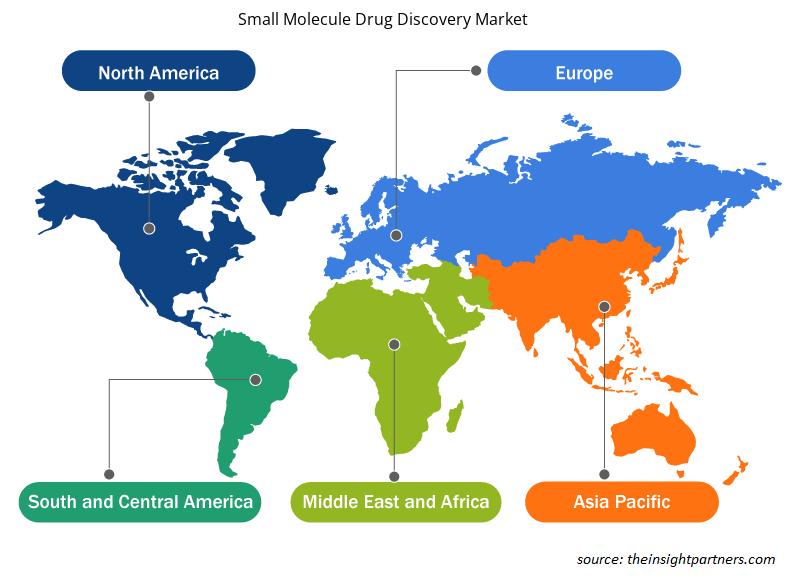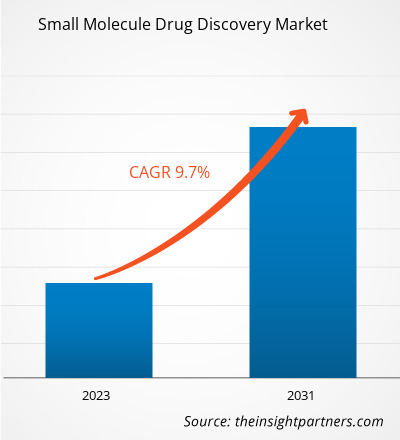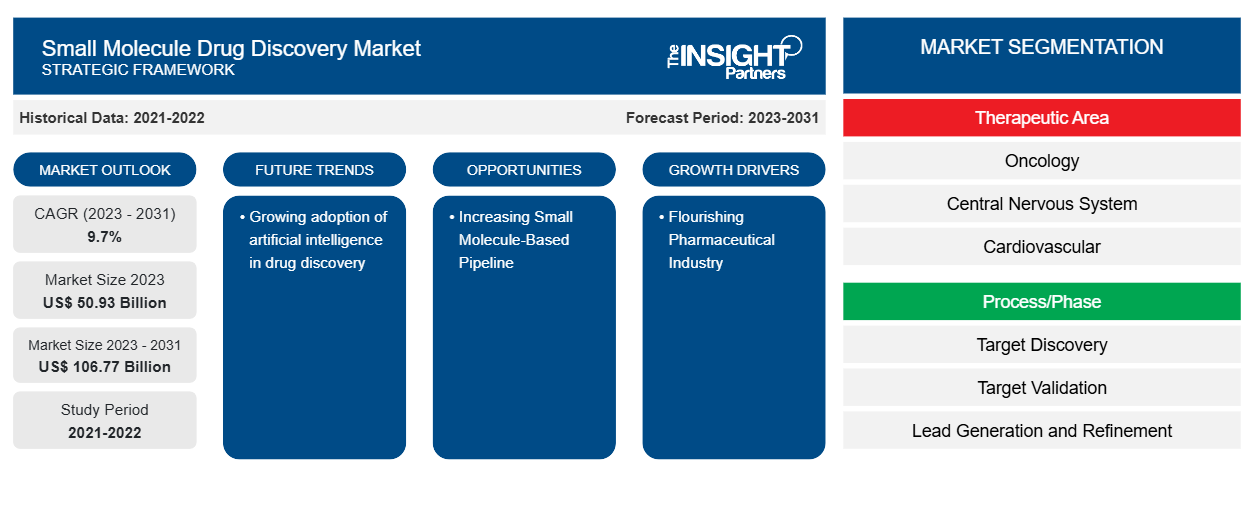Der Markt für die Entdeckung kleiner Moleküle soll von 50,93 Milliarden US-Dollar im Jahr 2023 auf 106,77 Milliarden US-Dollar im Jahr 2031 anwachsen. Der Markt soll zwischen 2023 und 2031 eine durchschnittliche jährliche Wachstumsrate (CAGR) von 9,7 % verzeichnen. Der zunehmende Einsatz künstlicher Intelligenz bei der Entdeckung von Medikamenten dürfte ein zukünftiger Trend auf dem Markt sein.
Marktanalyse für die Entdeckung niedermolekularer Arzneimittel
Der Markt für die Entdeckung kleiner Moleküle wird hauptsächlich durch die zunehmende Forschung und Entwicklung von Pharma- und Biotechnologieunternehmen bei der Entdeckung neuer Medikamente, Regierungsinitiativen und die Verbreitung von Krebs vorangetrieben. Weitere Faktoren, die zur Marktexpansion beitragen, sind die Globalisierung klinischer Studien, schnelle Fortschritte bei den damit verbundenen Technologien und eine steigende Nachfrage nach CROs für die Durchführung klinischer Studien. Darüber hinaus bietet die wachsende Pipeline auf der Basis kleiner Moleküle eine Chance für das Wachstum des Marktes für die Entdeckung kleiner Moleküle.
Marktübersicht zur Entdeckung niedermolekularer Arzneimittel
Der asiatisch-pazifische Raum wird im Prognosezeitraum voraussichtlich die höchste durchschnittliche jährliche Wachstumsrate verzeichnen. Ein Aufschwung des technologischen Fortschritts, ein Anstieg der Zusammenarbeit (zur Entwicklung der Genomforschung) zwischen asiatischen und westlichen Ländern, ein Rückgang der Preise für DNA-Sequenzierung und eine steigende Prävalenz genetischer und anderer Zielkrankheiten treiben den Markt für die Entdeckung kleiner Moleküle im asiatisch-pazifischen Raum voran. Der Markt im asiatisch-pazifischen Raum wird voraussichtlich aufgrund des steigenden BIP wachsen, das zum Wachstum der Pharmaindustrie führt. Darüber hinaus fördert das steigende verfügbare Einkommen die Einführung fortschrittlicher Gesundheitstechniken . Aufgrund der oben genannten Faktoren besteht daher ein enormes Potenzial für den Markt für die Entdeckung kleiner Moleküle.
Passen Sie diesen Bericht Ihren Anforderungen an
Sie erhalten kostenlos individuelle Anpassungen an jedem Bericht, einschließlich Teilen dieses Berichts oder einer Analyse auf Länderebene, eines Excel-Datenpakets sowie tolle Angebote und Rabatte für Start-ups und Universitäten.
-
Holen Sie sich die wichtigsten Markttrends aus diesem Bericht.Dieses KOSTENLOSE Beispiel umfasst eine Datenanalyse von Markttrends bis hin zu Schätzungen und Prognosen.
Treiber und Chancen auf dem Markt für die Entdeckung niedermolekularer Arzneimittel
Florierende Pharmaindustrie mit starkem Anstieg der F&E-Aktivitäten
Die Pharmaindustrie ist eine der F&E-intensivsten Branchen der Welt. Es werden Anstrengungen unternommen, um die Bedürfnisse der Patienten effektiver und effizienter zu erfüllen. Die Kosten von Medikamenten sind für Pharmaunternehmen ein Hauptanliegen , da sie auf ihre F&E-Aktivitäten setzen, um die beabsichtigten Kostenziele zu erreichen. Im letzten Jahrzehnt ist die Zahl der jährlich neu zugelassenen niedermolekularen Arzneimittel drastisch gestiegen. Die Food and Drug Administration (FDA) hat im Jahr 2023 55 neue Medikamente zugelassen. Die kleinen Moleküle dominierten die Zulassungen neuer Medikamente im Jahr 2023 und machten 62 % aller zugelassenen neuen molekularen Einheiten (NME) aus. Weltweit sind die USA ein führendes Land in Bezug auf F&E-Investitionen, und das Land hat im letzten Jahrzehnt über 50 % der neuen Moleküle der Welt produziert. Eine Zunahme der Zulassungen hat zu wachsenden Investitionen der Unternehmen in die Entwicklung von niedermolekularen Arzneimitteln geführt, da diese das Potenzial zur Behandlung mehrerer schwerer Krankheiten haben.NME) approved. Globally, the US is a leading country in terms of R&D investments, and the country produced over 50% of the world's new molecules in the past decade. An increase in approval has led to growing investments by companies for the development of small molecule drugs due to their potential in treating several severe diseases.
F&E-Investitionen großer Pharmaunternehmen
Unternehmen |
2022 (Milliarden US-Dollar) |
2023 (Milliarden US-Dollar) |
|
Takeda Pharmaceutical Co Ltd Pharmaceutical Co Ltd |
4.2 |
5.08 |
|
Pfizer Inc |
11.4 |
10.6 |
|
Grifols SA SA |
427,05 |
432,71 |
Hinweis: Für die Darstellung der Währungen wird der aktuelle Umrechnungskurs berücksichtigt.
Quelle: Geschäftsberichte und The Insight Partners Analyse
Die F&E-Ausgaben sind von entscheidender Bedeutung für die Bemühungen der Unternehmen, neue Produkte zu entdecken, zu untersuchen und herzustellen, Vorauszahlungen zu leisten, bestehende Ergebnisse zu verbessern und die Wirksamkeit der Produkte und die Einhaltung gesetzlicher Vorschriften vor der Markteinführung nachzuweisen. Diese Investitionen variieren je nach Bedarf und Nachfrage nach Arzneimittelentdeckungen. Die Kosten umfassen Materialien, verwendete Vorräte und Mitarbeitergehälter sowie die Kosten für die Entwicklung der Qualitätskontrolle. Laut dem Bericht der PhRMA-Mitgliedsunternehmen 2021 investierten die 15 umsatzstärksten Pharmaunternehmen insgesamt 133 Milliarden US-Dollar in F&E, und etwa 44 % der gesamten F&E-Investitionen flossen in die Arzneimittelentdeckung. Die steigenden F&E-Investitionen der Unternehmen treiben also das Wachstum des Marktes für die Entdeckung niedermolekularer Arzneimittel voran.
Wachsende Pipeline auf Basis kleiner Moleküle bietet Chancen für Marktwachstum
Die Pharmaindustrie entwickelt sich ständig weiter und es besteht immer Bedarf an neuen, innovativen Therapieansätzen zur Behandlung verschiedener chronischer Erkrankungen. Die Zulassungen von Arzneimitteln auf Basis kleiner Moleküle haben in den letzten fünf Jahren aufgrund ihrer Wirksamkeit bei einer Vielzahl von Indikationen zugenommen. Die Pipelines für Arzneimittelkandidaten auf Basis kleiner Moleküle wachsen für eine breite Palette therapeutischer Anwendungen, darunter Onkologie, Bluthochdruck, Diabetes und entzündliche Erkrankungen. Viele große und kleine Pharmaunternehmen sind an der Entwicklung mehrerer Arzneimittel auf Basis kleiner Moleküle beteiligt.
Die wachsende Pipeline an Arzneimitteln auf Basis kleiner Moleküle für verschiedene Indikationen kurbelt wiederum die Arzneimittelforschungsaktivitäten in der gesamten Branche an.
Zusammengesetzter Name |
Verbindungstyp |
Name der Firma |
Klinische Phase |
Anzeige |
|
PF-06821497 |
Kleines Molekül |
Pfizer Inc. |
Phase 1 |
Krebs |
|
PF-06873600 |
Kleines Molekül |
Pfizer Inc. |
Phase 1 |
Metastasierter Brustkrebs |
|
PF-06939999 |
Kleines Molekül |
Pfizer Inc. |
Phase 1 |
Solide Tumoren |
|
PF-06952229 |
Kleines Molekül |
Pfizer Inc. |
Phase 1 |
Krebs |
|
PF-06826647 |
Kleines Molekül |
Pfizer Inc. |
Phase 1 |
Colitis ulcerosa |
|
PF-07038124 |
Kleines Molekül |
Pfizer Inc. |
Phase 1 |
Atopische Dermatitis |
|
PF-06842874 |
Kleines Molekül |
Pfizer Inc. |
Phase 1 |
Pulmonale Hypertonie |
|
PF-06865571 |
Kleines Molekül |
Pfizer Inc. |
Phase 1 |
Nichtalkoholische Steatohepatitis (NASH) mit Leberfibrose |
|
PF-06882961 |
Kleines Molekül |
Pfizer Inc. |
Phase 1 |
Diabetes mellitus Typ 2, Fettleibigkeit |
|
PF-07081532 |
Kleines Molekül |
Pfizer Inc. |
Phase 1 |
Diabetes mellitus Typ 2, Fettleibigkeit |
|
R835 |
Kleines Molekül |
Rigel Pharmaceuticals, Inc. |
Phase 1 |
Entzündlich Störungen |
|
R552 |
Kleines Molekül |
Rigel Pharmaceuticals, Inc. |
Phase 1 |
Entzündlich Störungen |
|
SY-1425 |
Kleines Molekül |
Syros Pharmaceuticals, Inc. |
Phase 2 |
Antimykotika (AML) |
Quelle: Unternehmensnachrichten und The Insight Partner Analysis
Segmentierungsanalyse des Marktberichts zur Entdeckung niedermolekularer Arzneimittel
Wichtige Segmente, die zur Ableitung der Marktanalyse für die Entdeckung niedermolekularer Arzneimittel beigetragen haben, sind Therapiebereich und Prozess/Phase.
- Basierend auf dem Therapiebereich ist der Markt für die Entdeckung niedermolekularer Arzneimittel in Onkologie, Zentralnervensystem, Herz-Kreislauf, Atemwege, Orthopädie, Immunologie, seltene Krankheiten und andere Therapiebereiche unterteilt. Das Segment Onkologie hatte im Jahr 2023 den größten Marktanteil.
- Nach Prozess/Phase ist der Markt in Zielfindung, Zielvalidierung, Lead-Generierung und -Verfeinerung sowie präklinische Entwicklung segmentiert. Das Segment Lead-Generierung und -Verfeinerung dominierte den Markt im Jahr 2023.
Marktanteilsanalyse für die Entdeckung niedermolekularer Arzneimittel nach geografischen Gesichtspunkten
Der geografische Umfang des Marktberichts zur Entdeckung niedermolekularer Arzneimittel ist hauptsächlich in fünf Regionen unterteilt: Nordamerika, Asien-Pazifik, Europa, Süd- und Mittelamerika sowie Naher Osten und Afrika. In Bezug auf den Umsatz dominierte Nordamerika den Markt im Jahr 2023. Zunehmende Forschung und Entwicklung durch Pharma- und Biotechnologieunternehmen zur Entdeckung neuer Medikamente, wachsende Investitionen in Pharmazeutika und die Verbreitung von Krebs gehören zu den Faktoren, die das Wachstum des nordamerikanischen Marktes für die Entdeckung niedermolekularer Arzneimittel beschleunigen sollen. Die USA sind der größte und am schnellsten wachsende Markt für die Entdeckung niedermolekularer Arzneimittel. Die zunehmende Verbreitung chronischer Krankheiten wie Herz-Kreislauf-Erkrankungen und Krebs treibt das Marktwachstum im Land in erster Linie an. Laut der American Cancer Society werden im Jahr 2024 voraussichtlich etwa 2 Millionen Menschen an neuen Krebserkrankungen erkranken und etwa 611.000 Todesfälle in den USA erwartet. Aufgrund dieses Szenarios wird das US-Gesundheitssystem massiv in die Forschung und Entwicklung neuartiger Arzneimittelmoleküle investiert. Darüber hinaus wird erwartet, dass eine starke Medikamentenpipeline zusammen mit Zulassungen für therapeutische Bereiche für niedermolekulare Arzneimittel den regionalen Markt ankurbeln wird. Neben der steigenden Zahl zugelassener Medikamente dürfte das zunehmende Bewusstsein für fortschrittliche Therapeutika im Prognosezeitraum für das Wachstum des Marktes für die Entdeckung niedermolekularer Arzneimittel verantwortlich sein.
Regionale Einblicke in den Markt für niedermolekulare Arzneimittelentdeckung
Die regionalen Trends und Faktoren, die den Markt für Arzneimittelentdeckung mit kleinen Molekülen während des gesamten Prognosezeitraums beeinflussen, wurden von den Analysten von Insight Partners ausführlich erläutert. In diesem Abschnitt werden auch Marktsegmente und Geografien für Arzneimittelentdeckung mit kleinen Molekülen in Nordamerika, Europa, im asiatisch-pazifischen Raum, im Nahen Osten und Afrika sowie in Süd- und Mittelamerika erörtert.

- Erhalten Sie regionale Daten zum Markt für niedermolekulare Arzneimittelentdeckung
Umfang des Marktberichts zur Entdeckung niedermolekularer Arzneimittel
| Berichtsattribut | Details |
|---|---|
| Marktgröße im Jahr 2023 | 50,93 Milliarden US-Dollar |
| Marktgröße bis 2031 | 106,77 Milliarden US-Dollar |
| Globale CAGR (2023 - 2031) | 9,7 % |
| Historische Daten | 2021-2022 |
| Prognosezeitraum | 2023–2031 |
| Abgedeckte Segmente |
Nach Therapiebereich
|
| Abgedeckte Regionen und Länder |
Nordamerika
|
| Marktführer und wichtige Unternehmensprofile |
|
Dichte der Marktteilnehmer für die Entdeckung niedermolekularer Arzneimittel: Auswirkungen auf die Geschäftsdynamik verstehen
Der Markt für die Entdeckung von Arzneimitteln mit kleinen Molekülen wächst rasant. Dies wird durch die steigende Nachfrage der Endnutzer aufgrund von Faktoren wie sich entwickelnden Verbraucherpräferenzen, technologischen Fortschritten und einem größeren Bewusstsein für die Vorteile des Produkts vorangetrieben. Mit der steigenden Nachfrage erweitern Unternehmen ihr Angebot, entwickeln Innovationen, um die Bedürfnisse der Verbraucher zu erfüllen, und nutzen neue Trends, was das Marktwachstum weiter ankurbelt.
Die Marktteilnehmerdichte bezieht sich auf die Verteilung der Firmen oder Unternehmen, die in einem bestimmten Markt oder einer bestimmten Branche tätig sind. Sie gibt an, wie viele Wettbewerber (Marktteilnehmer) in einem bestimmten Marktraum im Verhältnis zu seiner Größe oder seinem gesamten Marktwert präsent sind.
Die wichtigsten Unternehmen, die auf dem Markt für die Entdeckung niedermolekularer Arzneimittel tätig sind, sind:
- Bristol-Myers Squibb Co
- Merck KGaA
- GSK Plc
- Boehringer Ingelheim International GmbH
- Thermo Fisher Scientific Inc
- ICON Plc
Haftungsausschluss : Die oben aufgeführten Unternehmen sind nicht in einer bestimmten Reihenfolge aufgeführt.

- Überblick über die wichtigsten Akteure auf dem Markt für niedermolekulare Arzneimittelforschung
Neuigkeiten und aktuelle Entwicklungen zum Markt für niedermolekulare Arzneimittelentdeckung
Der Markt für die Entdeckung niedermolekularer Arzneimittel wird durch die Erhebung qualitativer und quantitativer Daten nach Primär- und Sekundärforschung bewertet, die wichtige Unternehmensveröffentlichungen, Verbandsdaten und Datenbanken einschließen. Nachfolgend sind einige der Entwicklungen auf dem Markt aufgeführt:
- Oncodesign Services (ODS) hat ZoBio übernommen, ein niederländisches CRO, das auf biophysikbasierte Arzneimittelentdeckung kleiner Moleküle spezialisiert ist. Mit dieser Übernahme kann ODS seine Expertise und Fähigkeiten auf dem Gebiet der Entdeckung kleiner Moleküle stärken und zu einem vollständig integrierten Angebot erweitern, das die innovativen Programme seiner Kunden von der Zielvalidierung bis zur Kandidatenauswahl unterstützt. (Quelle: Oncodesign Services, Unternehmenswebsite, Januar 2024)
- Merck ist neue strategische Kooperationen zur Arzneimittelentdeckung eingegangen, die darauf abzielen, leistungsstarke, auf künstlicher Intelligenz (KI) basierende Design- und Entdeckungsfähigkeiten zu nutzen und so die Forschungsanstrengungen des Unternehmens weiter voranzutreiben. Die Partnerschaft von BenevolentAI (London, Großbritannien) und Exscientia (Oxford, Großbritannien) soll mehrere neuartige Arzneimittelkandidaten für die klinische Entwicklung mit First-in-Class- und Best-in-Class-Potenzial in den wichtigsten Therapiebereichen Onkologie, Neurologie und Immunologie hervorbringen. (Quelle: Merck, Unternehmenswebsite, September 2023)
Marktbericht zur Entdeckung niedermolekularer Arzneimittel: Umfang und Ergebnisse
Der Bericht „Marktgröße und Prognose für die Entdeckung niedermolekularer Arzneimittel (2021–2031)“ bietet eine detaillierte Analyse des Marktes, die die folgenden Bereiche abdeckt:
- Marktgröße und Prognose für die Entdeckung niedermolekularer Arzneimittel auf globaler, regionaler und Länderebene für alle wichtigen Marktsegmente, die im Rahmen des Projekts abgedeckt sind
- Markttrends bei der Entdeckung niedermolekularer Arzneimittel sowie Marktdynamiken wie Treiber, Hemmnisse und wichtige Chancen
- Detaillierte PEST- und SWOT-Analyse
- Marktanalyse zur Entdeckung niedermolekularer Arzneimittel, die wichtige Markttrends, globale und regionale Rahmenbedingungen, wichtige Akteure, Vorschriften und aktuelle Marktentwicklungen umfasst
- Branchenlandschaft und Wettbewerbsanalyse, die die Marktkonzentration, Heatmap-Analyse, prominente Akteure und aktuelle Entwicklungen auf dem Markt für die Entdeckung niedermolekularer Arzneimittel umfasst
- Detaillierte Firmenprofile
- Historische Analyse (2 Jahre), Basisjahr, Prognose (7 Jahre) mit CAGR
- PEST- und SWOT-Analyse
- Marktgröße Wert/Volumen – Global, Regional, Land
- Branchen- und Wettbewerbslandschaft
- Excel-Datensatz
Aktuelle Berichte
Verwandte Berichte
Erfahrungsberichte
Grund zum Kauf
- Fundierte Entscheidungsfindung
- Marktdynamik verstehen
- Wettbewerbsanalyse
- Kundeneinblicke
- Marktprognosen
- Risikominimierung
- Strategische Planung
- Investitionsbegründung
- Identifizierung neuer Märkte
- Verbesserung von Marketingstrategien
- Steigerung der Betriebseffizienz
- Anpassung an regulatorische Trends























 Kostenlose Probe anfordern für - Markt für die Entdeckung niedermolekularer Arzneimittel
Kostenlose Probe anfordern für - Markt für die Entdeckung niedermolekularer Arzneimittel